Although DE-MOSFET is useful in special applications, it does not enjoy widespread use. However, it played an important role in history because it was part of the evolution towards the E-mode MOSFET, a device that has revolutionized the electronic industry. E-MOSFET has become enormously important, in digital electronics and. In the absence of E-MOSFET’s the personal computers (PCs) that are now so widespread would not exist.
Construction of an EMOSFET:
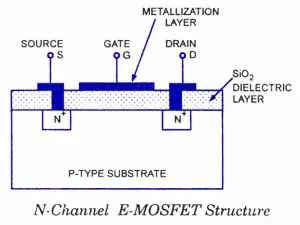
Figure shows the construction of an N-channel E-MOSFET. The main difference between the construction of DE-MOSFET and that of E-MOSFET, as we see from the figures given below the E-MOSFET substrate extends all the way to the silicon dioxide (SiO2) and no channels are doped between the source and the drain. Channels are electrically induced in these MOSFETs, when a positive gate-source voltage VGS is applied to it.
Operation of an EMOSFET:
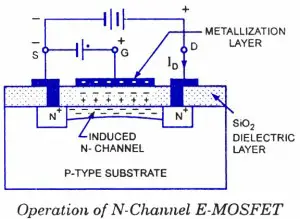
As its name indicates, this MOSFET operates only in the enhancement mode and has no depletion mode. It operates with large positive gate voltage only. It does not conduct when the gate-source voltage VGS = 0. This is the reason that it is called normally-off MOSFET. In these MOSFET’s drain current ID flows only when VGS exceeds VGST [gate-to-source threshold voltage].
When drain is applied with positive voltage with respect to source and no potential is applied to the gate two N-regions and one P-substrate from two P-N junctions connected back to back with a resistance of the P-substrate. So a very small drain current that is, reverse leakage current flows. If the P-type substrate is now connected to the source terminal, there is zero voltage across the source substrate junction, and the–drain-substrate junction remains reverse biased.
When the gate is made positive with respect to the source and the substrate, negative (i.e. minority) charge carriers within the substrate are attracted to the positive gate and accumulate close to the-surface of the substrate. As the gate voltage is increased, more and more electrons accumulate under the gate. Since these electrons can not flow across the insulated layer of silicon dioxide to the gate, so they accumulate at the surface of the substrate just below the gate. These accumulated minority charge carriers N -type channel stretching from drain to source. When this occurs, a channel is induced by forming what is termed an inversion layer (N-type). Now a drain current start flowing. The strength of the drain current depends upon the channel resistance which, in turn, depends upon the number of charge carriers attracted to the positive gate. Thus drain current is controlled by the gate potential.
Since the conductivity of the channel is enhanced by the positive bias on the gate so this device is also called the enhancement MOSFET or E- MOSFET.
The minimum value of gate-to-source voltage VGS that is required to form the inversion layer (N-type) is termed the gate-to-source threshold voltage VGST. For VGS below VGST, the drain current ID = 0. But for VGS exceeding VGST an N-type inversion layer connects the source to drain and the drain current ID is large. Depending upon the device being used, VGST may vary from less than 1 V to more than 5 V.
JFETs and DE-MOSFETs are classified as the depletion-mode devices because their conductivity depends on the action of depletion layers. E-MOSFET is classified as an enhancement-mode device because its conductivity depends on the action of the inversion layer. Depletion-mode devices are normally ON when the gate-source voltage VGS = 0, whereas the enhancement-mode devices are normally OFF when VGS = 0.
Characteristics of an EMOSFET.
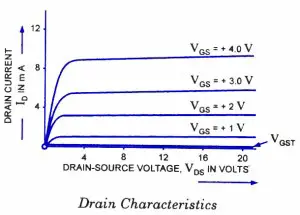
Drain characteristics of an N-channel E-MOSFET are shown in figure. The lowest curve is the VGST curve. When VGS is lesser than VGST, ID is approximately zero. When VGS is greater than VGST, the device turns- on and the drain current ID is controlled by the gate voltage. The characteristic curves have almost vertical and almost horizontal parts. The almost vertical components of the curves correspond to the ohmic region, and the horizontal components correspond to the constant current region. Thus E-MOSFET can be operated in either of these regions i.e. it can be used as a variable-voltage resistor (WR) or as a constant current source.
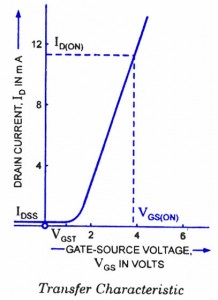
Figure shows a typical transconductance curve. The current IDSS at VGS <=0 is very small, being of the order of a few nano-amperes. When the VGS is made positive, the drain current ID increases slowly at first, and then much more rapidly with an increase in VGS. The manufacturer sometimes indicates the gate-source threshold voltage VGST at which the drain current ID attains some defined small value, say 10 u A. A current ID (0N, corresponding approximately to the maximum value given on the drain characteristics and the values of VGS required to give this current VGs QN are also usually given on the manufacturers data sheet.
The equation for the transfer characteristic does not obey equation. However it does follow a similar “square law type” of relationship. The equation for the transfer characteristic of E-MOSFETs is given as:
ID=K(VGS-VGST)2
Schematic Symbols of EMOSFET.
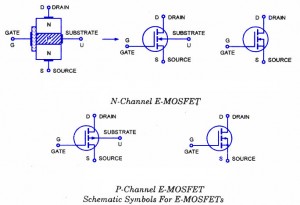
Schematic symbols for an N-channel E-MOSFET are shown in figure. For zero value of VGS, the E-MOSFET is OFF because there is no conducting channel between source and drain. Each of schematic symbols shown in figures, has broken channel line to indicate this normally OFF condition. As we know that for VGS exceeding the threshold voltage VGST, an N-type inversion layer, connecting the source to drain, is created. In each of the schematic symbols, the arrow points to this inversion layer, which acts like an N-channel when the device is conducting. In each case, the fact that the device has an insulated gate is indicated by the gate not making direct contact with the channel. The schematic symbol shown in figure shows the source and substrate internally connected, while the other symbol shown in figure shows the substrate connection brought out separately from the source.
The schematic symbols for a P-channel E-MOSFET are also shown. In these cases the arrow points outwards.

2 Comments
So Easy to understand..
I really needed this.. glad I found it.. thanks a lot..
the contents are really useful to understand the operarion of rhe device with simple language and schematic diagrams. its helpful